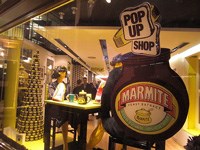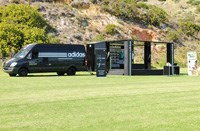How to ensure the perfect pop
One reason provided for their recent rise has been the knock-on recessionary effect that has seen hundreds of stores left empty and boarded up across the country. Personally, though, we prefer to take the creative high ground that brands are looking to engage consumers in new and unexpected environments to create memorable brand experiences.
Whether you're a fan of them or not, the pop-up store craze is gaining momentum and can no longer be ignored. For this reason, we've developed our own little Stretch DIY Pop-Up Store model to help spread the message of temporary brand retail love.

I. Why are you popping?
Having started out in 1996 as a solution for a small LA clothing brand to generate hype about limited edition products, pop-up stores have emerged to meet different commercial and brand goals. These include increasing sales (particularly relevant for smaller brands, such as pop-up restaurants trying to avoid high street rentals), testing the market, launching a product, raising brand awareness and creating PR buzz.
NB: It's worth bearing in mind that not all pop-up stores need to be retail pop-up stores. Some might, in fact, offer no retail experience whatsoever, with the emphasis placed on product/service consumption and in turn brand awareness and brand building. The need for retail will depend on the objectives the brands are trying to achieve.
To pop correctly, it's crucial brands identify why they 'want to pop' to ensure they don't put the cart before the proverbial trend horse.

II. Popping at just the right moment
Choosing when to pop is a strategic decision, get it wrong and you risk hearing crickets instead of footfall traffic. Know your population! Consumers will no doubt appreciate the thought that went into not only giving them a brand experience but also leveraging off a personal insight garnered during research.
Examples of this enabling function include:
- Providing winter warming solutions during colder months (think soups, coffees, etc);
- Busy tourist periods (think summer in CT) can be targeted specifically to help out with retail relief needed due to increased footfall;
- 'Event fever' often leads to a temporary associated trend. See the example of the Wimbledon pop-up store to meet tennis fever.

III. Pick one! Pop-up store variations
Once you've identified what you are looking to achieve by your pop-up campaign and how it's relevant to your consumer, there are three main store variations from which to choose:
- Mobile: pop-up on wheels, ability to take to multiple locations
- Semi-permanent: more traditional use of traditional retail space for temporary experience
- Guerrilla: non-mobile, PR-rich structures established in non-traditional retail spaces
Your selection of chosen pop-up form should ideally be driven by your exposure objective. In other words, are you looking at maximum consumer interactions or is your campaign focused on ROI through digital and PR exposure?
IV. Producing the pop
Pop-up stores are great in theory but do bring with them some important production considerations. Ignore these at your peril!
A few very important production planning phases must not be missed:
- Obtain the relevant permissions: whether a guerrilla tactic or an outdoor pop-up store, you will need to receive permission from the local councils and traffic departments. If it is a retail pop-up store, you might be able to piggy-back off existing stores or will need to obtain additional vendor/selling licenses.
- Design: pop-up stores need to be attention-grabbing and innovative to the point that they create talkability as a visual concept innovation. Well thought-out layouts need to be in place for easy flow in an unusually small space.
- Be self-sufficient: depending on your chosen form, provision needs to be made for electricity, recycling, water, cash collection/paypoints and, of course, health and safety, etc.
- Create an experience: make fun happen! Include relevant brand activities, co-brand partners, games, applications and interactions in order to communicate with consumers for as long an impact as fully possible.
- NB - make noise: have an opening event, get relevant celebrities and media attending and seed information to traditional and non-traditional media.
- Build communities: data capture is crucial viral amplification and user-generated content (UGC). Incorporate social media, hash tags and on-site data capture for extended consumer engagement. Run competitions for UGC-sharing.
Pop-up stores will be judged on their ability to generate talkability through unexpected innovation.
While brand managers across South Africa are no doubt scrounging around for extra budget to make them happen, there needs to be perspective and a clear plan in place, from inception to execution. These ventures need to be treated as stand-alone marketing campaigns with clear objectives and measurables in place.
Get it right and you'll be on even the most sceptical of consumers' lips for having the retail ability to snap, crackle and, well, you know what.
Mike Silver, director of Stretch Experiential Marketing, also contributed to the writing of this how-to guide.
About Catherine Mavrocoleas
- How to ensure the perfect pop - 11 Jun 2012
View my profile and articles...
